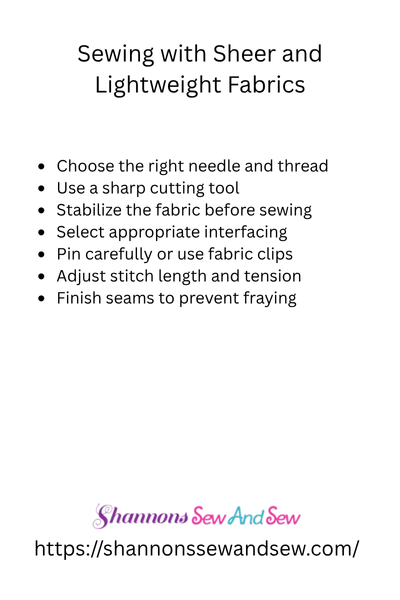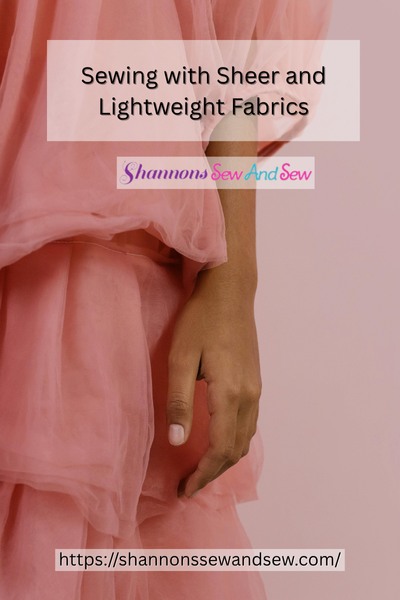Sewing Clothes
Sewing with Sheer and Lightweight Fabrics
When I first tried sewing with sheer and lightweight fabrics, I’ll admit, I was a little intimidated. These delicate materials can be tricky to work with, and they often seem to have a mind of their own. But once I figured out a few key tricks, sewing with these fabrics became one of my favorite challenges. If you’re new to it (or even if you’ve sewn for a while but never dared to tackle sheers), don’t worry—I’ve got your back.
Read More About Sewing with Sheer and Lightweight Fabrics

Why You Should Try Sewing with Sheer and Lightweight Fabrics
Sewing with sheer and lightweight fabrics can be surprisingly rewarding. These fabrics create gorgeous, airy garments that move beautifully—think of a flowy summer dress or a delicate blouse. They can also add a touch of elegance and sophistication to your wardrobe without weighing you down. But the truth is, while the results are stunning, the process requires a bit of finesse.
I remember the first time I sewed sheer fabric—it felt like trying to wrangle a piece of tissue paper with a needle and thread! But trust me, once you understand how to handle these materials, you’ll love the softness and flow they bring to your creations.
More Things to Know About Sewing with Sheer and Lightweight Fabrics

The Right Tools for the Job
Sewing with sheer and lightweight fabrics isn’t impossible, but it does require the right tools. First things first, make sure you’re using the right needle. A fine, sharp needle is key to preventing snags or holes in the fabric. I recommend a 60/8 or 70/10 size needle for most sheer materials.
And let’s talk thread for a second—use a lightweight thread like cotton or polyester that matches the delicacy of the fabric. The last thing you want is a thick thread that will weigh your project down or cause the fabric to bunch up.
Also, make sure your sewing machine is set up correctly. Lower the presser foot pressure to prevent the fabric from slipping, and if you’re working with particularly slippery fabric, try using a walking foot. Trust me, this will make your life so much easier!
Cutting Sheer and Lightweight Fabrics: Handle with Care
Here’s a tip I wish I had known when I started: cutting sheer and lightweight fabrics can feel like trying to cut through a cloud. These fabrics are so light that they shift and slide around easily. I remember trying to cut my fabric, only to realize it had moved out of place. It was frustrating.
To avoid this, I recommend using a sharp pair of fabric scissors and cutting your fabric on a flat surface. If you’re worried about it shifting, use some fabric weights or pins (just be careful not to leave pin marks). And always make sure to cut carefully—sheer fabrics can fray easily, so make sure you get clean, precise edges. A rotary cutter can also work wonders for a cleaner cut.
Sewing Techniques for Sheer and Lightweight Fabrics
Now, let’s get to the fun part: actually sewing! The key here is patience—don’t rush, and take it one step at a time. For the best results, you should always sew with the right side of the fabric facing up. This helps you avoid any puckering or unwanted folds.
When I first started sewing with sheers, I was shocked at how often the fabric would slip under the presser foot. It’s like the fabric was actively trying to avoid my sewing machine! That’s when I learned the trick of using a tissue paper stabilizer. This lightweight paper helps hold the fabric in place and prevents it from shifting around while you sew. And don’t worry—it’s super easy to tear away once you’re done.
Also, consider using French seams. These are a great way to finish the edges of sheer fabrics while keeping everything neat and tidy. Plus, they add a professional touch to your garment. Trust me, once you learn how to do these, you’ll feel like a pro.
Mistakes to Avoid When Sewing with Sheer and Lightweight Fabrics
It’s easy to make mistakes when working with sheer and lightweight fabrics, especially if you’re new to them. Here are a few things I learned the hard way:
- Don’t skip the test run: Always do a small test on a scrap piece of fabric before starting on your main project. This allows you to adjust the settings on your sewing machine and test your stitches.
- Avoid using too many pins: Sheer fabrics can get marked by pins, so try to use fabric weights instead. If you must pin, do it sparingly.
- Don’t forget about fabric finishing: If you’re not careful, sheer fabrics can fray easily. Be sure to finish the edges with a serger or a zigzag stitch to prevent any unraveling.
- Don’t press too hard: Sheer fabrics are delicate, so you should always use a low heat setting on your iron. Too much heat can burn the fabric or leave marks. I always use a pressing cloth just to be safe.
Adding Elegance to Your Closet One Stitch at a Time
Sewing with sheer and lightweight fabrics can feel intimidating at first, but with the right tools and techniques, you’ll soon be whipping up beautiful, airy creations. Whether you’re making a delicate blouse or a flowy skirt, these fabrics add elegance and beauty to any garment. Just take your time, be patient, and remember that practice makes perfect.
Are you ready to tackle your next sewing project with sheer fabrics? I’m excited to see what you create! You might be surprised at how much fun it is once you get the hang of it.




















